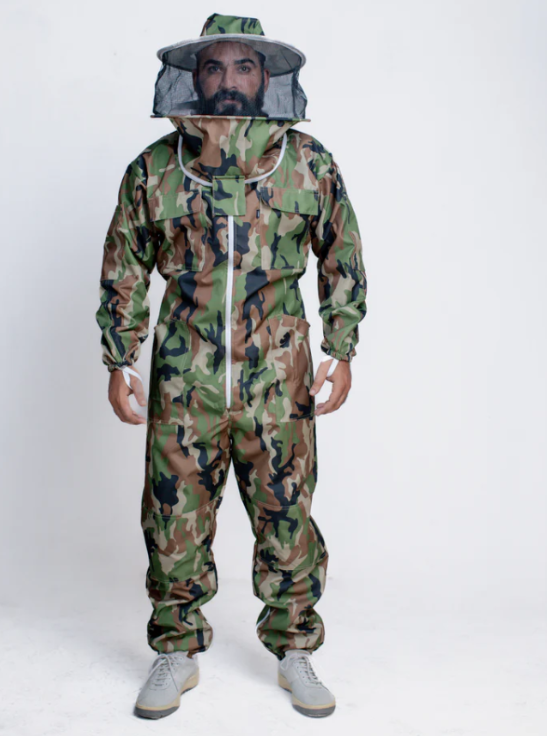How protective clothing went from homemade veils to high-tech armor for beekeepers — and why it matters more today than ever before.
Beekeeping is one of the world’s oldest professions, dating back thousands of years. But while the bees haven’t changed all that much, the way we dress to work with them certainly has. What began with crude face coverings and woven straw hats has now evolved into smart suits with mesh panels, cooling layers, and built-in tech.
The story of beekeeping attire isn’t just about fashion — it’s about safety, confidence, and adapting to a world where climate, environment, and urban life all affect our buzzing little friends. And today, anyone searching for a beekeeper suit for sale in USA will find more options, styles, and innovations than ever before.
Let’s take a look at where it all started — and where it’s headed next.
🐝 1. Ancient Times: Smoke, Straw, and Skin
Early beekeepers — from ancient Egypt to Mesopotamia — had no fancy gear. Most worked with bare hands, uncovered arms, and perhaps a thick cloth draped over their heads. The main strategy was simple: distract the bees with smoke, move carefully, and hope for the best.
Some early protective methods included:
- Straw hats with face cloths
- Heavy tunics made of wool or animal hides
- Charcoal or sage smoke blown directly into the hive
There was no mass production, no suits — just instincts and courage. Needless to say, stings were part of the job.
🧺 2. The Early Veil Era (1700s–1800s)
As formal beekeeping grew across Europe and the American colonies, so did the need for better protection. During this time, the beekeeping veil became a staple — a simple mesh net tied to a wide-brimmed hat, shielding the face and neck.
Attire still remained basic:
- Long sleeves and trousers tucked into boots
- Leather gloves (when available)
- Homemade veils with lace or mesh
Protection was partial at best — but it was a step forward. Beekeepers were beginning to recognize the value of personal safety, even if the solutions were homemade.
👨🌾 3. The Birth of the Full Beekeeper Suit (Early 1900s)
With the growth of commercial beekeeping in the early 20th century came the invention of the first full-body beekeeping suit. Made from heavy canvas or cotton, these suits were often hot, stiff, and bulky — but they did their job.
Key features:
- Zip-up design with elastic cuffs
- Thick material to prevent stings
- Veil attached to a pith helmet or stiff hat
Though clunky, these suits drastically reduced stings and allowed beekeepers to work more confidently around larger hives. And for the first time, beekeeping attire began to look like a profession — not just a pastime.
💡 4. The Rise of Ventilation and Comfort (Late 20th Century)
As beekeeping became more widespread — from backyard hobbyists to rooftop urban farms — manufacturers started improving gear for comfort and convenience. The focus shifted from just sting protection to mobility, breathability, and visibility.
This era introduced:
- Lightweight poly-cotton blends
- Mesh ventilation panels
- Zippered hoods and elastic thumb loops
- Removable veils
Gloves also got a redesign — with softer leather, more grip, and better sensitivity. These improvements made gear more appealing to hobbyists and encouraged safer practices, especially in hot climates.
🛰️ 5. Today’s Smart Suits: Modern Design Meets Technology
Fast forward to today — and beekeeping suits have gone high-tech. Modern suits don’t just protect you from stings — they help you work better, faster, and smarter.
Modern innovations include:
- Triple-layer mesh suits for airflow + protection
- UV-reflective outer fabrics to reduce heat
- Suits with built-in tool loops, knee pads, and phone holders
- Anti-bacterial linings and machine-washable materials
- Suits compatible with hive sensors and data loggers
Some premium suits are even being integrated with wearable tech, allowing commercial beekeepers to track inspections or record hive health on the go.
If you’re shopping today, it’s easy to find a beekeeper suit for sale in USA that suits your climate, comfort level, and budget. Whether you’re inspecting one hive or managing fifty, modern gear can make the entire experience safer and more enjoyable.
🔁 Then vs. Now — A Quick Comparison
| Feature | Early Attire (Pre-1900s) | Today’s Beekeeper Suits |
| Material | Wool, straw, thick cotton | Mesh blends, poly-cotton, ventilated |
| Protection | Partial (mostly face/arms) | Full-body sting-proof coverage |
| Comfort | Heavy and hot | Lightweight, breathable |
| Vision/Visibility | Limited mesh or cloth veils | Wide-view veils with anti-fog mesh |
| Extras | None | Tool loops, cooling pads, tech pockets |
| Availability | Homemade | Wide variety of beekeeper suit for sale in USA |
Why the Right Suit Still Matters Today
Even with all the advancements in hive technology, the beekeeper suit remains your first line of defense. Whether you’re a beginner or a seasoned apiarist, having the right suit:
- Keeps you calm (which keeps bees calm)
- Protects your skin and eyes from stings
- Builds your confidence, especially when handling aggressive colonies
- Lets you focus on inspection, not on panic
And with dozens of modern beekeeper suit for sale in USA, you don’t need to settle for hot, outdated, or ill-fitting gear anymore.
🧭 Final Thoughts: Respect the Past, Invest in the Present
The evolution of beekeeping attire reflects the journey of beekeepers themselves — from bold pioneers with straw hats to today’s smart, sustainability-driven protectors of pollinators.
The more we understand bees, the more we realize that protecting ourselves allows us to protect them better.
So whether you’re suiting up for your first hive or upgrading your tenth, take a moment to appreciate how far we’ve come — and then choose a suit that takes you even further. You’ll find a wide range of modern beekeeper suit for sale in USA — built not just to keep you safe, but to make every inspection easier, cooler, and smarter.







